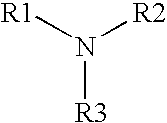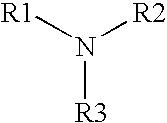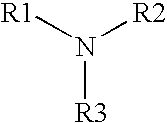Alkylamine as an antimicrobial agent in ophthalmic compositions
a technology of ophthalmic composition and alkylamine, which is applied in the direction of drug compositions, detergent compounding agents, peptide/protein ingredients, etc., can solve the problems of inability to provide perfect in-eye performance, complex contact lens solutions, and adverse changes in ocular tissues and tear film
- Summary
- Abstract
- Description
- Claims
- Application Information
AI Technical Summary
Problems solved by technology
Method used
Image
Examples
example 1
[0072] As noted above in the Background of the Invention section, non-ionic surfactants are commonly used in microbiology tests to stop a quaternary ammonium / alkylamine activity. One of the significant differences between contact lens care system and re-circulating water systems is that the former requires the presence of a large amount of a surfactant as a cleaning agent while the latter is not compatible with surfactants due to foaming problems. Anionic surfactant and polymeric / non-polymeric quaternary ammoniums form ion-pair or precipitate in an aqueous solution and therefore, cannot be mixed together. The presence of non-ionic surfactant at a cleaning agent level usually would cause a significant, if not complete, loss of antimicrobial activity for non-polymeric quaternary ammonium or alkylamine. As shown in Table 1, the addition of the non-ionic surfactant tocopherol polyethylene glycol succinate (“TPGS”) halts the ammonium / alkylamine activity.
TABLE 1Formulationw / v %w / v %Cety...
example 2
[0073] The formulations shown in Table 2A were evaluated for their antimicrobial activity for contact lens disinfecting. As may be seen, this formulation exhibited a very high antimicrobial activity.
TABLE 2AIngredient% w / w% w / wMyristylamine0.00030.0005Tetronic ® 13070.050.05HPMC0.150.15Propylene Glycol0.50.5Tris0.0210.021Tris.HCl0.0550.055NaCl0.650.65KCl0.140.14pH 7.8Log DropLog DropS. marcescens1.182.6S. aureus2.874.8P. aeruginosa>4.63>4.63C. albicans3.674.41F. solani>4.34>4.34
[0074] It is easily seen from the data in Table 2 that the myristylamine has strong antimicrobial activity against C. albicans, as well as other organisms.
[0075] In contrast as shown in Table 2B, Dodecylamine, a C12 primary amine which is water soluble, has very weak antimicrobial activity and, therefore, not suitable as a disinfectant for contact lens cleaning and disinfecting.
TABLE 2BIngredient% w / w% w / wDodecylamine0.00050.0003Taurine0.050.05Propylene Glycol0.500.50Tetronic 13070.050.05NaEDTA0.010.01HP...
example 3
[0076] As shown by the formulations and resulting log reductions shown in Table 3, the antimicrobial activity of an alkylamine having the following formula:
[0077] where R1 is a C13-17 alkylamine, and R2 and R3 are each independently H or —CH3, may be further enhanced if one or more other types of antimicrobial agents are added.
TABLE 3Formulationw / v %w / v %Myristylamine0.00050.0005WSCP0.0010.0NaClO20.010.0NaCitrate0.40.0Taurine0.050.05Propylene Glycol0.500.50T13070.050.05HPMC0.150.15Tris0.0210.021Tris.HCl0.0550.055NaCl0.650.65KCl0.140.14Log DropLog DropS. marcescens3.11.68S. aureus3.742.93P. aeruginosa>4.63>4.63C. albicans2.953.29F. solani>4.34>4.34
[0078] These results are collaborated by the formulation and resulting log reductions shown in Table 4, and by the formulations and resulting log reductions shown in Table 5.
TABLE 4Formulationw / v %w / v %Myristylamine0.00030.0003PHMB00.00003Taurine0.050.05Propylene Glycol0.500.50Tetronic 11070.050.05HPMC0.150.15Tris0.0210.021Tris.HCl0.0...
PUM
| Property | Measurement | Unit |
|---|---|---|
| molecular weight | aaaaa | aaaaa |
| molecular weight | aaaaa | aaaaa |
| weight ratio | aaaaa | aaaaa |
Abstract
Description
Claims
Application Information
 Login to View More
Login to View More - R&D Engineer
- R&D Manager
- IP Professional
- Industry Leading Data Capabilities
- Powerful AI technology
- Patent DNA Extraction
Browse by: Latest US Patents, China's latest patents, Technical Efficacy Thesaurus, Application Domain, Technology Topic, Popular Technical Reports.
© 2024 PatSnap. All rights reserved.Legal|Privacy policy|Modern Slavery Act Transparency Statement|Sitemap|About US| Contact US: help@patsnap.com










